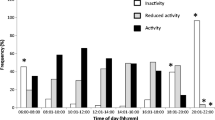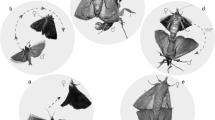Abstract
Males and virgin females of the citrus fruit borer Ecdytolopha aurantiana Lima, displayed two flight peaks during a 24-hr period, one at dawn and the other at dusk in an orange grove near Gavião Peixoto, São Paulo, Brazil. During the day, when temperatures were highest and relative humidity lowest, most individuals rested on leaves in the lower and middle crown. Moths rapidly moved higher in the crown after sunset, and many were observed flying above the tree canopy. This behavior was mainly associated with mating. Males and virgin females marked with fluorescent powder of different colors were observed in the dark with the aid of a black light. Mating was observed only in the upper crown of citrus trees from 6:00 to 9:00 PM, with a peak (64%) between 7:00 and 8:00 PM. Males of E. aurantiana were captured in traps baited either with virgin females or female extracts, suggesting the use of a long-range sex pheromone. At close distance (1–2 cm), males and females displayed a short-range communication behavior, with males exposing hairpencils and vibrating their wings. Females were frequently stimulated to contact the body of a male before copulation. The mean duration of copulation was 1 hr 40 min.
Similar content being viewed by others
REFERENCES
ANONYMOUS. 2000. Tecnologia contra o bicho-furão. Rev. Fundecitrus 96:8-10.
AHMAD, T. R. and AL-GHARBAWI, Z. A. 1986. Effects of pheromone trap design and placement on catches of codling moth males. J. Appl. Entomol. 102:52-57.
BAKER, T. C. and CARDÈ, R. T. 1979. Courtship behavior of the oriental fruit moth (Grapholitha molesta): Experimental analysis and consideration of the role of sexual selection in the evolution of courtship pheromones in the Lepidoptera. Ann. Entomol. Soc. Am. 72:173-188.
BORDEN, A. D. 1931. Some field observations on codling moth behavior. J. Econ. Entomol. 24:1137-1145.
DREISIG, H. 1986. Timing of daily activities in adult Lepidoptera. Entomol. Gen. 12:25-43.
DUSTAN, G. G. 1964. Mating behaviour of the oriental fruit moth, Grapholitha molesta (Busck) (Lepidoptera: Olethreutidae). Can. Entomol. 96:1087-1093.
FONSECA, J. P. da. 1934. Combate a lagarta das laranjas Gymnandrosoma aurantiarum Costa Lima. Chac. Quint. 50:215-216.
GARCIA, M. S. 1999. Bioecologia e potencial de controle biológico de Ecdytolopha aurantiana (Lima, 1927) (Lepidoptera: Tortricidae), o bicho-furão-dos-citros, através de Trichogramma pretiosum Riley, 1879. Piracicaba, 1998. PhD thesis. Escola Superior de Agricultura "Luiz de Queiroz," Universidade de São Paulo (in Portuguese), 118 pp.
GARCIA, M. S. and PARRA, J. R. P. 1999. Compara¸cão de dietas artificiais, com fontes protéicas variáveis, para a cria¸cão de Ecdytolopha aurantiana (Lima) (Lepidoptera: Tortricidae). An. Soc. Entomol. Brasil 28:219-232.
GARCIA, M. S., PARRA, J. R. P., IAROSSI, A. R., and KASTEN, P. JR., 1998. Bioecologia do bicho-furão e perspectivas de controle. Laranja 19:249-260.
HAMILTON, D. W. and STEINER, L. F. 1939. Light traps and codling moth control. J. Econ. Entomol. 32:867-872.
HOWELL, J. F. 1995. Reproductive biology, pp. 157-174, in L. P. S. van der Geest and H. H. Evenhuis (eds.). Tortricid Pests: Their Biology, Natural Enemies and Control, Vol. 5. Elsevier, Amesterdam.
LEWIS, T. and MACAULAY, E. D. M. 1976. Design and elevation of sex-attractant traps for the pea-moth, Cydia nigricana (Steph.), and the effect of plume shape on catches. Ecol. Entomol. 1:175-187.
LEWIS, T. and TAYLOR, L. R. 1964. Diurnal periodicity of flight by insects. Trans. R. Entomol. Soc. London 116:393-476.
LIMA, A. C. 1927. Sobre um novo microlepidoptero, cuja lagarta é praga das laranjeiras no Distrito Federal. Chac. Quint. 36:33-35.
LIMA, A. C. 1945. Insetos do Brasil. Lepidópteros. 1º Parte. Rio de Janeiro, Escola Nacional de Agronomia. 5:346-353. (S´erie did´atica, 7). 379 pp.
MCNALLY, P. S. and BARNES, M. M. 1981. Effects of codling moth pheromone trap to placement, orientation and density on trap catches. Envion. Entomol. 10:22-26.
MEYRICK, E. 1931. Exotic microlepidoptera. Vol. 4. Parts 3-12. [Pp. 129-160]. Taylor & Francis, [London]. [1930-1937]: 642 pp.
NAKANO, O. and SOARES, M. G. 1995. Bicho-furão: Biologia, hábitos e controle. Laranja 16:187-208.
PICKLES, A. 1936. Insect pests of Trinidad crops with some suggestions for their control. Proc. Agric. Soc. Trinidad Tobago 36:339-348.
POINTING, P. J. 1961. The biology and behaviour of the European pine shoot moth, Rhyacionia buoliana (Schiff.), in southern Ontario. I. Adult. Can. Entomol. 93:1098-1112.
PRATES, H. S. and PINTO, W. B. S. 1988. Ocorrência da mariposa das laranjas (Gymnandrosoma aurantiarum Lima, 1927) na citricultura paulista. Laranja 9:117-124.
PRATES, H. S. and PINTO, W. B. S. 1991. Bicho-furão, um grave problema para a citricultura paulista. Laranja 12:425-434.
PRATES, H. S. and PINTO, W. B. S. 1995. Ocorrência do bicho-furão nas principais regiões citrícolas paulistas. Laranja 16:237-242.
QUIRING, D. T. 1994. Diel activity pattern of a nocturnal moth, Zeiraphera canadensis, in nature. Entomol. Exp. Appl. 73:111-120.
REDFERN, J. W. JR. and DI GIáCOMO, O. A. S. 1991. Conheça o bicho furão para controlálo melhor. Inf. Coopercitrus 52:12-14.
RIEDL, H., HOYING, S. A., BARNETT, W. W., and DETAR, J. E. 1979. Relationship of within-tree placement of the pheromone trap to codling moth catches, Environ. Entomol. 8:765-769.
SCHULTZ, E. T. 1939. La mariposa de los naranjos (Gymnandrosoma sp.). Rev. Ind. Agric. Tucuman 29:87-90.
SOUTHWOOD, T. R. E. 1995. Ecological Methods: With Particular Reference to the Study of Insect Populations, 2nd ed. Chapman & Hall, London, 524 pp.
TURGEON, J. J. 1985. Life cycle and behavior of the spruce budmoth, Zeiraphera Canadensis (Lepidoptera: Olethreutidae), in New Brunswick. Can. Entomol. 117:1239-1247.
TURGEON, J. J., NELSON, N., and KETTELA, E. G. 1987. Reproductive biology of the spruce budmoth, Zeiraphera canadensis Mut.&Free. (Lepidoptera: Tortricidae: Olethreutidae), in NewBrunswick. Can. Entomol. 119:361-364.
WEISSLING, T. J. and KNIGHT, A. L. 1995. Vertical distribution of codling moth adults in pheromonetreated and untreated plots. Entomol. Exp. Appl. 77:271-275.
WHITE, G. L. 1993. Outbreak of Ecdytolopha aurantianum (Lima) on citrus in Trinidad. FAO Plant Prot. Bull. 41:130-132.
YOTHERS, M. A. 1927. Summary of three years' tests of trap baits for capturing the codling moth. J. Econ. Entomol. 20:567-575.
Author information
Authors and Affiliations
Rights and permissions
About this article
Cite this article
Bento, J.M.S., Parra, J.R.P., Vilela, E.F. et al. Sexual Behavior and Diel Activity of Citrus Fruit Borer Ecdytolopha aurantiana. J Chem Ecol 27, 2053–2065 (2001). https://doi.org/10.1023/A:1012294921058
Issue Date:
DOI: https://doi.org/10.1023/A:1012294921058




